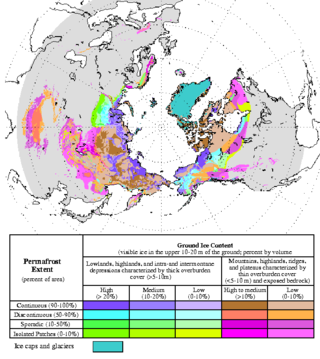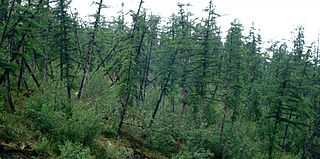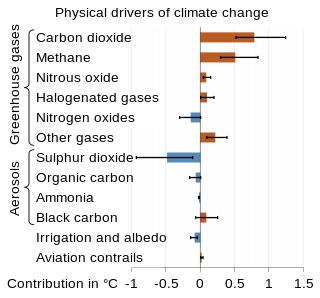
In physical geography, tundra is a type of biome where tree growth is hindered by frigid temperatures and short growing seasons. The term tundra comes through Russian тундра from the Kildin Sámi word тӯндар meaning "uplands", "treeless mountain tract". There are three regions and associated types of tundra: Arctic tundra, alpine tundra, and Antarctic tundra.

Permafrost is soil or underwater sediment which continuously remains below 0 °C (32 °F) for two or more years. Land-based permafrost can include the surface layer of the soil, but if the surface is too warm, it may still occur within a few centimeters of the surface down to hundreds of meters. It usually consists of ice holding in place a combination of various types of soil, sand, and rock, though in ice-free ground, perennially frozen non-porous bedrock can serve the same role.

Thermokarst is a type of terrain characterised by very irregular surfaces of marshy hollows and small hummocks formed as ice-rich permafrost thaws. The land surface type occurs in Arctic areas, and on a smaller scale in mountainous areas such as the Himalayas and the Swiss Alps.

Pingos are intrapermafrost ice-cored hills, 3–70 m (10–230 ft) high and 30–1,000 m (98–3,281 ft) in diameter. They are typically conical in shape and grow and persist only in permafrost environments, such as the Arctic and subarctic. A pingo is a periglacial landform, which is defined as a non-glacial landform or process linked to colder climates. It is estimated that there are more than 11,000 pingos on Earth. The Tuktoyaktuk peninsula area has the greatest concentration of pingos in the world with a total of 1,350 pingos. There is currently remarkably limited data on pingos.
Yedoma is an organic-rich Pleistocene-age permafrost with ice content of 50–90% by volume. Yedoma are abundant in the cold regions of eastern Siberia, such as northern Yakutia, as well as in Alaska and the Yukon.

Drunken trees, tilted trees, or a drunken forest, is a stand of trees rotated from their normal vertical alignment.

Major environmental issues caused by contemporary climate change in the Arctic region range from the well-known, such as the loss of sea ice or melting of the Greenland ice sheet, to more obscure, but deeply significant issues, such as permafrost thaw, as well as related social consequences for locals and the geopolitical ramifications of these changes. The Arctic is likely to be especially affected by climate change because of the high projected rate of regional warming and associated impacts. Temperature projections for the Arctic region were assessed in 2007: These suggested already averaged warming of about 2 °C to 9 °C by the year 2100. The range reflects different projections made by different climate models, run with different forcing scenarios. Radiative forcing is a measure of the effect of natural and human activities on the climate. Different forcing scenarios reflect things such as different projections of future human greenhouse gas emissions.

Arctic methane release is the release of methane from seas and soils in permafrost regions of the Arctic. While it is a long-term natural process, methane release is exacerbated by global warming. This results in a positive feedback cycle, as methane is itself a powerful greenhouse gas.

The Northeast Science Station of the RAS is an Arctic research station located in Chersky, Sakha Republic in Northeast Siberia. It is one of the world's three largest Arctic stations.

Sergey Aphanasievich Zimov is a Russian geophysicist who specialises in arctic and subarctic ecology. He is the Director of Northeast Scientific Station, a senior research fellow of the Pacific Institute for Geography, and one of the founders of Pleistocene Park. He is best known for his work in advocating the theory that human overhunting of large herbivores during the Pleistocene caused Siberia's grassland-steppe ecosystem to disappear and for raising awareness as to the important roles permafrost and thermokarst lakes play in the global carbon cycle.

Atmospheric methane is the methane present in Earth's atmosphere. The concentration of atmospheric methane—one of the most potent greenhouse gases—is increasing due to methane emissions, and is causing climate change.

Climate change feedbacks are important in the understanding of global warming because feedback processes amplify or diminish the effect of each climate forcing, and so play an important part in determining the climate sensitivity and future climate state. Feedback in general is the process in which changing one quantity changes a second quantity, and the change in the second quantity in turn changes the first. Positive feedback amplifies the change in the first quantity while negative feedback reduces it.

A methane chimney or gas chimney is a rising column of natural gas, mainly methane within a water or sediment column. The contrast in physical properties between the gas phase and the surrounding water makes such chimneys visible in oceanographic and geophysical data. In some cases, gas bubbles released at the seafloor may dissolve before they reach the ocean surface, but the increased hydrocarbon concentration may still be measured by chemical oceanographic techniques.

Pleistocene Park is a nature reserve on the Kolyma River south of Chersky in the Sakha Republic, Russia, in northeastern Siberia, where an attempt is being made to re-create the northern subarctic steppe grassland ecosystem that flourished in the area during the last glacial period.

The permafrost carbon cycle or Arctic carbon cycle is a sub-cycle of the larger global carbon cycle. Permafrost is defined as subsurface material that remains below 0o C for at least two consecutive years. Because permafrost soils remain frozen for long periods of time, they store large amounts of carbon and other nutrients within their frozen framework during that time. Permafrost represents a large carbon reservoir that is seldom considered when determining global terrestrial carbon reservoirs. Recent and ongoing scientific research however, is changing this view.
Jeffrey Paul "Jeff" Chanton is the 2017-2018 Robert O. Lawton Distinguished Professor and John Widmer Winchester professor of oceanography at Florida State University. His research interests include Arctic methane release from the thawing of permafrost. Chanton co-created the Master of Science in aquatic environmental sciences at FSU with Nancy Marcus.
Susan M. Natali is an American ecologist. She is the Arctic program director and senior scientist at the Woodwell Climate Research Center, where her research focuses on the impact of climate change on terrestrial ecosystems, primarily on Arctic permafrost. She is also the project lead for Permafrost Pathways, a new initiative launched in 2022 with funding from TED's Audacious Project. On Monday, April 11, 2022, Dr. Natali gave a TED Talk introducing the Permafrost Pathways project at the TED2022 conference in Vancouver, BC.
Jill L. Bubier is a professor emerita of environmental science at Mount Holyoke College (MHC). Her research examines how Northern ecosystems respond to climate change.
Merritt Turetsky is an American ecosystem ecologist and a professor at the University of Colorado Boulder. She serves as Director of the Institute for Arctic and Alpine Research (INSTAAR). Her research considers fire regimes, climate change and biogeochemical cycling in Arctic wetlands. Turetsky is a member of the Permafrost Action Team (SEARCH), a group of scientists who translate and deliver science to decision-makers.
Retrogressive thaw slumps (RTS), are a type of landslide that occur in the terrestrial Arctic's permafrost region of the circumpolar Northern Hemisphere when an ice-rich section thaws. RTSs develop quickly and can extend across several hectares modifying Arctic coastlines and permafrost terrain. They are the most active and dynamic feature of thermokarst—the collapse of the land surface as ground ice melts. They are thermokarst slope failures due to abrupt thawing of ice-rich permafrost or glaciated terrains. These horseshoe-shaped landslides contribute to the thawing of hectares of permafrost annually and are considered to be one of the most active and dynamic features of thermokarst—the "processes and landforms that involve collapse of the land surface as a result of the melting of ground ice." They are found in permafrost or glaciated regions of the Northern Hemisphere—the Tibetan Plateau, Siberia, from the Himalayas to northern Greenland, and in northern Canada's Northwest Territories (NWT), the Yukon Territories, Nunavut, and Nunavik and in the American state of Alaska. The largest RTS in the world is in Siberia—the Batagaika Crater, also called a "megaslump", is one-kilometre-long and 100 metres (330 ft) deep and it grows a 100 feet (30 m) annually. The land began to sink, and the Batagaika Crater began to form in the 1960s, following clear-cutting of a section of forested area.














